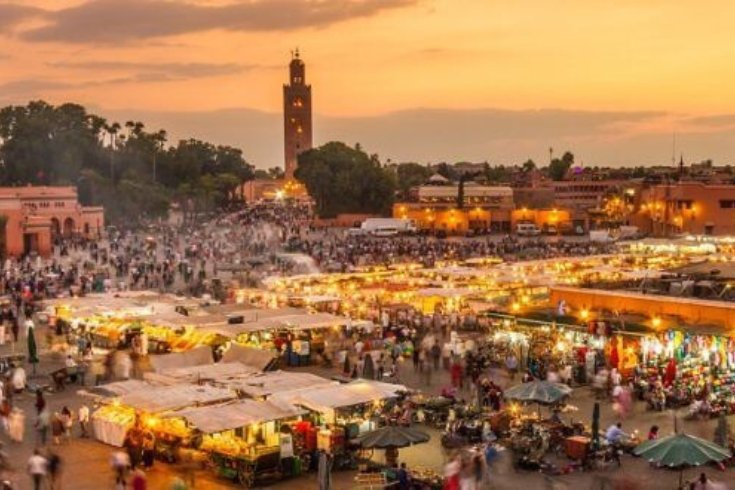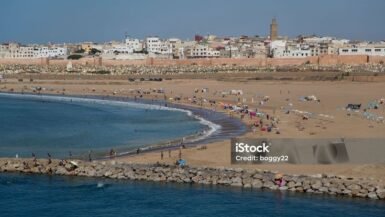At the heart of Marrakech’s medina beats a unique pulse, that of Jemaa el-Fna Square, a true theater of authentic Moroccan life. This emblematic square, recognized by UNESCO as a masterpiece of oral and intangible heritage of humanity, offers total immersion into Morocco’s cultural soul.
Table of Contents
A living heritage at the center of Marrakech
Strategic location in the medina
Jemaa el-Fna Square occupies a privileged position at the heart of Marrakech’s historic medina. Situated between the traditional souks to the north and the majestic Koutoubia Mosque to the west, it constitutes the natural convergence point of all paths in the imperial city. This central position makes it the essential crossroads between the different quarters of the medina, creating a constant flow of life and exchanges.
A millennial heritage
The square’s origins date back to the 11th century, when it already served as a central square under the Almoravid dynasty. Its name, “Jemaa el-Fna,” is subject to several interpretations: some see it as the “mosque of nothingness,” others as the “assembly square.” This etymological ambiguity adds to its mystery and historical richness.
The rhythm of the square: perpetual transformation
Morning awakening: relative serenity
In the early hours of the day, Jemaa el-Fna Square reveals a more peaceful face. Fresh orange juice vendors set up their colorful stalls, creating bright spots on the still-calm esplanade. This is the ideal moment to appreciate the surrounding architecture and understand the geography of this emblematic place.
The first artists make their appearance: snake charmers with their wicker baskets, monkey trainers with amusing acrobatics, and a few morning storytellers who begin gathering their first listeners. This period offers a more intimate approach to the square, allowing visitors to familiarize themselves with the space before the nighttime effervescence.
The twilight metamorphosis
As soon as the sun begins its descent behind the Koutoubia palm trees, Jemaa el-Fna Square begins its spectacular transformation. Within a few hours, it becomes Morocco’s largest open-air popular restaurant, welcoming thousands of diners who come to taste the authentic flavors of Moroccan gastronomy.
The installation of hundreds of food stalls follows a well-orchestrated ritual. Each location has its specialty, its loyal clientele, and its particular atmosphere. Smoke from grilled foods rises into the evening air, mixing the aromas of spices, grilled meats, and traditional pastries.
A conservatory of Moroccan popular arts
Guardians of oral tradition
The storytellers of Jemaa el-Fna Square are heirs to a millennial tradition. Seated at the center of circles of captivated listeners, they perpetuate the ancestral art of narration in dialectal Arabic or Berber. Their stories, enriched with expressive gestures and dramatic intonations, transport the audience into the universe of Berber legends, folk tales, and heroic epics.
These masters of speech play a crucial role in preserving Moroccan oral heritage. Each evening, they transmit to new generations the values, beliefs, and collective imagination of their culture, making the square a true living conservatory.
Musicians: ambassadors of ancestral rhythms
The musical diversity of the square reflects Morocco’s cultural richness. Gnawa groups, with their resonant metallic instruments and hypnotic songs, create bewitching atmospheres that attract circles of music lovers. Their performances, inherited from African spiritual traditions, offer a mystical dimension to the square experience.
Berber music formations bring the sounds of the Atlas Mountains, while Moroccan popular music orchestras offer melodies more familiar to the general public. This cultural polyphony makes each evening on the square a celebration of Moroccan musical diversity.
Performance arts and craftsmanship
The square’s acrobats and gymnasts perpetuate ancestral circus traditions. Their human pyramids, somersaults, and demonstrations of physical strength fascinate children and adults alike. These shows, transmitted from generation to generation, constitute a unique sporting and artistic heritage.
Henna artists, mainly women, offer their services with remarkable dexterity. Their complex geometric patterns, inspired by Berber and Arab traditions, transform hands and feet into true temporary works of art. This ancestral practice, linked to beauty rituals and celebrations, finds its most accessible expression to the public on the square.
The gastronomic experience: an authentic culinary journey
Flavors of tradition
Dining on Jemaa el-Fna Square offers total immersion into popular Moroccan gastronomy. Each specialized stall offers its specialties in a friendly and authentic atmosphere. Tangia Marrakchia, the emblematic dish of the red city, slowly simmers in its clay jars, developing unique flavors found nowhere else.
Harira, a traditional soup rich in legumes and spices, warms the cool winter evenings. Grilled foods – lamb skewers, spiced kefta, fragrant merguez – sizzle on the braziers, spreading their irresistible aromas into the night air.
The art of sharing
The culinary experience of the square transcends simple dining. Long communal tables create spontaneous bonds between diners of all nationalities. This social dimension of the meal, deeply rooted in Moroccan culture, transforms each dinner into a moment of encounter and intercultural exchange.
The square as gateway to the souks
Transition to the merchant universe
On the north side of the square open the main entrances to Marrakech’s souks, this millennial commercial labyrinth where Moroccan artisanal traditions are perpetuated. This proximity makes Jemaa el-Fna the natural gateway to the fascinating universe of traditional commerce.
The souks, organized by guilds and specialties, offer a journey through ancestral know-how: leatherwork, coppersmithing, weaving, pottery, spices and perfumes. Each alley tells the story of a trade, a technique, a tradition transmitted from master to apprentice for centuries.
Practical advice for an optimal visit
Timing and approach
To grasp all the richness of the square, it should be visited at different times. A first morning visit allows you to understand the geography of the place and photograph the architecture in soft light. The evening visit, from 5 PM, offers the spectacle of progressive transformation until the nocturnal peak. For comprehensive travel planning, consult the official Morocco tourism website for updated information.
Respectful interaction with artists
The performances on the square are part of an economic ecosystem where artists’ remuneration largely depends on tips. Photographing or filming generally implies a financial contribution that should be accepted graciously. This practice, far from being a constraint, participates in preserving these living traditions.
Gastronomic discovery
For the culinary experience, favoring the most frequented stalls generally guarantees product freshness. Don’t hesitate to observe the preparations, ask questions to the cooks, and let yourself be guided by their recommendations. For food safety tips when traveling in Morocco, refer to travel health guidelines. The authenticity of the experience lies as much in discovering flavors as in human exchange.
A heritage to preserve and celebrate
Jemaa el-Fna Square represents much more than a tourist attraction: it embodies the continuity of a civilization, the permanence of traditions in a constantly changing world. Its recognition by UNESCO underlines the universal importance of this living heritage.
Each visitor becomes, during their presence, an actor in this cultural continuity. By participating in the life of the square, listening to storytellers, applauding musicians, sharing a meal at popular stalls, they contribute to keeping alive this permanent theater of Moroccan culture.
Jemaa el-Fna Square is not a museum frozen in time, but a living organism that feeds on the energy of its visitors and the passion of its artists. It offers everyone the rare opportunity to be witness and participant in a millennial tradition that continues to write its history day after day, night after night, in the vibrant heart of Marrakech. For more insights into Morocco’s cultural heritage, explore the Moroccan Ministry of Culture resources.





Leave a reply